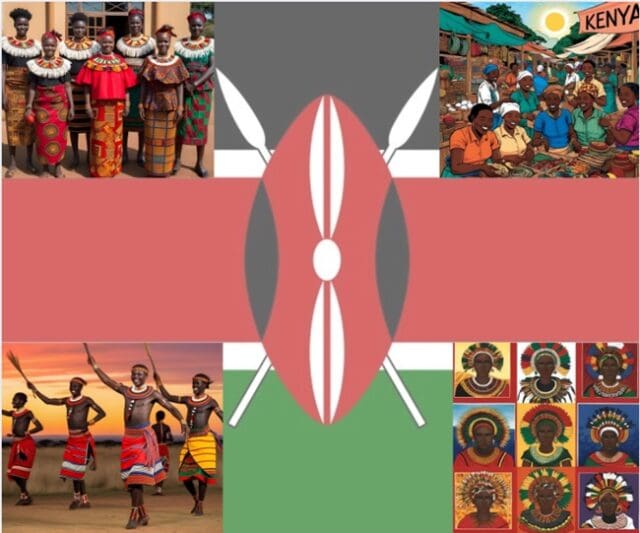
Kenya, a land where breathtaking landscapes meet vibrant cultural narratives, invites you to embark on an unforgettable journey.
From the majestic savannahs of the Maasai Mara to the bustling streets of Nairobi, this East African gem is a tapestry woven with rich traditions, diverse heritage, and warm hospitality.
Kenya boasts a rich and diverse heritage, with a blend of cultural traditions, historical sites, and natural beauty, including seven UNESCO World Heritage Sites and a diverse array of ethnic groups.
Here’s a deeper look into Kenya’s cultural and natural heritage:
Cultural Heritage:
- Ethnic Diversity:
Kenya is home to over 44 ethnic groups, each with its own unique language, customs, and traditions. - Major Ethnic Groups:
Some of the most prominent ethnic groups include the Kikuyu, Kalenjin, Luo, Luhya, and Maasai. - Maasai Culture:
The Maasai are known for their nomadic lifestyle, vibrant attire, and strong cultural traditions. - Swahili Culture:
The Swahili culture, a blend of African, Arab, and other influences, is particularly prominent along the Kenyan coast. - Traditional Values:
Kenyans value humility, concern for neighbors, and maintaining kinship ties. - Modern Adaptations:
While many Kenyans maintain traditional practices, they also adapt to modern values and lifestyles. - Languages:
Swahili is the national language, while English is the official language. - Religion:
Christianity is the dominant religion, followed by Islam. - Kenyan Cuisine:
Kenyan cuisine features a variety of dishes, including ugali (a staple food), nyama choma (grilled meat), and roasted vegetables. - Arts and Crafts:
Kenyan artists and artisans are known for their vibrant beadwork, pottery, and other traditional crafts. - Music and Dance:
Traditional music and dance play an important role in Kenyan culture, with various styles and rhythms depending on the region and ethnic group. - Historical Sites:
Kenya is home to numerous historical sites, including the Gedi ruins, Fort Jesus in Mombasa, and the Thimlich Ohinga Archaeological Site. - UNESCO World Heritage Sites:
Kenya has seven UNESCO World Heritage Sites, including Lamu Old Town, Fort Jesus, and the Kenya Lake System in the Great Rift Valley. - Sacred Mijikenda Kaya Forests:
These are sacred forests tied to Mijikenda traditions.
Natural Heritage:
- Biodiversity:
Kenya is a biodiversity hotspot, home to a wide variety of wildlife, including lions, elephants, giraffes, and rhinos. - National Parks and Reserves:
Kenya has numerous national parks and reserves, including the Maasai Mara, Amboseli, and Tsavo National Parks. - Mount Kenya:
The second-highest peak in Africa, Mount Kenya, is a major natural landmark and a biodiversity hotspot. - Lake Turkana:
Lake Turkana is a large, alkaline lake in the Great Rift Valley, known for its unique ecosystem and wildlife. - Kenya Lake System in the Great Rift Valley:
This system of lakes is a critical habitat for migratory birds. - Scenery:
Kenya’s landscapes range from the snow-capped slopes of Mount Kenya to the sunny beaches of the Indian Ocean, offering a variety of natural attractions.
Whether you’re trekking through the scenic highlands or engaging with indigenous communities, Kenya offers an unparalleled glimpse into the soul of Africa.
Here’s a more detailed look at some of the major ethnic groups in Kenya:
Bantu Groups:
- Kikuyu: The largest ethnic group in Kenya, residing primarily in the Central region, known for their agricultural and business prowess.
- Luhya: The second-largest ethnic group, found in western Kenya, known for their rich agricultural heritage.
- Kamba: A significant ethnic group, known for their martial traditions and agricultural practices.
- Kisii (Gusii): A Bantu-speaking group, known for their agricultural practices and close ties to the Luo.
- Meru: A Bantu-speaking group, closely related to the Kikuyu and Embu, known for their agricultural practices.
- Mijikenda: A group of nine Bantu-speaking ethnic groups in the coastal region, known for their traditions and practices associated with the Kaya forests.
Nilotic Groups:
- Luo:A Nilotic group, inhabiting the Lake Victoria basin and known for their cultural traditions.
- Kalenjin: A Nilotic group, traditionally pastoral, inhabiting the Rift Valley region.
- Maasai: A well-known Nilotic group, known for their pastoral lifestyle and vibrant culture, inhabiting the Rift Valley region and parts of Tanzania.
- Samburu: A Nilotic group, known for their pastoral lifestyle and close ties to the Maasai.
- Turkana: A Nilotic group, inhabiting the Turkana region, known for their pastoral and semi-nomadic lifestyle.
Other Groups:
- Somali: A Cushitic group, residing in the northeastern part of Kenya, known for their pastoral and semi-nomadic lifestyle.
- Swahili:A mixed ethnic group found along the Kenyan coast, with influences from African, Arab, and Persian cultures.
Whether you’re trekking through the scenic highlands or engaging with indigenous communities, Kenya offers an unparalleled glimpse into the soul of Africa.







